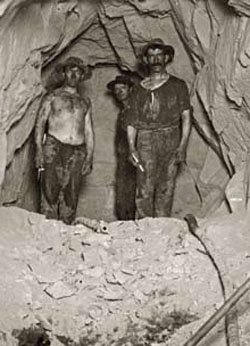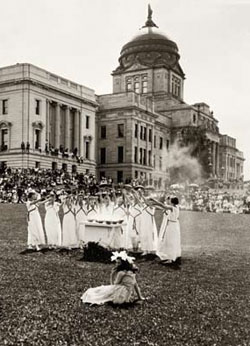Montana: Stories of the Land
Companion Website and Online Teacher's Guide
Chapter 10 - Politics and the Copper Kings, 1889-1904
Chapter 1 - Montana: Where the Land Writes History
Chapter 2 - People of the Dog Days
Chapter 3 - From Dog Days to Horse Warriors
Chapter 4 - Newcomers Explore the Region
Chapter 5 - Beaver, Bison, and Black Robes
Chapter 6 - Montana's Gold and Silver Boom
Chapter 7 - Two Worlds Collide
Chapter 8 - Livestock and the Open Range
Chapter 9 - Railroads Link Montana to the Nation
Chapter 10 - Politics and the Copper Kings
Chapter 11 - The Early Reservation Years
Chapter 12 - Logging in the "High Lonesome"
Chapter 13 - Homesteading This Dry Land
Chapter 14 - Towns Have Lives, Too
Chapter 15 - Progressive Montana
Chapter 16 - Montana and World War I
Chapter 17 - Montanans on the Move
Chapter 18 - The Great Depression Transforms Montana
Chapter 19 - World War II in Montana
Chapter 20 - Building a New Montana
Chapter 21 - A People's Constitution
Chapter 22 - Living in a New Montana
Educator Resources
Takeaways
-
Inspired by reading specialist Tammy Elser, who was in turn inspired by SKC graduate Taylor Crawford, we've created a "Takeaway" bookmark for every chapter of Montana: Stories of the Land. Before starting a chapter, print and cut out these bookmarks and distribute them to your students. Ask them to use the Takeaway to summarize the GIST of what they learn from reading assigned sections of the chapter. Remind them that they don't have much room, so they'll need to think before they write down the most important idea they want to take away from the section. Learn a little more about the GIST strategy.
-
Even though we've created Takeaways for every chapter, we don't recommend you have your students complete a Takeaway for every section of every chapter they read. That would be exceedingly tedious. However, used appropriately, they can be a useful tool for encouraging reflection and teaching students how to summarize information.
Websites and Online Lesson Plans
-
The Annotated Resource Set Politics and the Copper Kings, 1889-1904, includes links to photographs, maps, illustrations, and documents relating to the War of the Copper Kings and the era's political history. Many, but not all, of the images were also used to illustrate Chapter 10 of Montana: Stories of the Land. These sources can be used to build PowerPoints or to create DBQs or other primary-source based activities.
-
Looking to introduce your students to the legislative process? Download the "Guide to the Montana Legislature," a booklet for anyone wanting basic information about the way the Montana Legislature works and how best to get involved in the legislative process.
-
For a model lesson on analyzing political cartoons, see the Library of Congress's module, "Political Cartoons: Finding Point of View."
-
Butte historian George Everett has created a good summary of Butte labor history.
-
Explore Helena using the booklet Camp to Capitol: Step into Helena's Past. By comparing the historical photographs contained within to the streetscape today, students can gain an understanding of how Helena grew and an appreciation for the buildings that remain to reflect the community's rich history.
-
Butte’s Industrial Landscape is a PowerPoint and script created by Fred Quivik, Professor Emeritus of History, at Michigan Technological University. Originally presented as part of the NEH-funded workshop, "The Richest Hills: Mining in the Far West, 1860-1920," the PowerPoint examines industrial mining's social and environmental impacts, and can be adapted for classroom use, particularly in the upper grades.
-
Dig into Mining: The Story of Copper This interactive web-based program for students grades 6-8 uncovers the use of metals such as copper in our everyday life, and provides students a deeper understanding of today's hard rock mining industry.
-
Clark Fork Watershed Education Program (CFWEP) Find resources for teaching about the environmental consequences of copper mining and reclamation efforts.
Videos or DVDs
-
Chapter One, "When Copper Was King," (22 minutes) and Chapter Ten, "The Anaconda Mining Company," (16 minutes) of Montana Mosaic: 20th-Century People and Events. (Check your library. OPI donated a copy of this DVD to every public school in Montana. The DVD is also available as streaming video.) Find User Guides with discussion questions here.
-
Paupers Dream: Tribute to the Montana Hard Rock Miner, Joseph Campanella - 58 minutes.
-
Hidden Fire: The Great Butte Explosion - 60 minutes.
-
Remembering the Columbia Gardens - 60 minutes.
Possible Fieldtrips: View the Map
-
Bannack State Park, 24 miles southwest of Dillon
-
Copper King Mansion, Butte
-
World Museum of Mining, Butte
-
Daly Mansion, Hamilton
-
Helena (Use the booklet Camp to Capital: Step into Helena's Past, by Ellen Baumler et al, for a self-guided tour.)
-
Montana State Capitol, Helena
-
Original Governors Mansion, Helena
-
Virginia City, Montana
Chapter 10 Test and Answer Keys Page
The tests and answer keys are password protected.
You can contact us to receive the password:
- Martha Kohl - call (406) 444-4790 or email mkohl@mt.gov
- Melissa Hibbard - call (406) 444-4741 or email Melissa.Hibbard@mt.gov
Or, if you used the old system, the original username is now the new password. You will be asked for this case-sensitive password every time you open a new document.
Alignment to ELA Common Core Standards
Alignment to Content Standards and Essential Understandings Regarding Montana Indians (EU)


